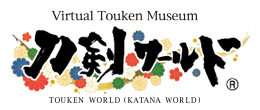The jigane refers to both the steel material itself and the pattern of kitae–hada that appears when the steel is folded and forged.
It takes about 10 kg of steel to make a Japanese sword. When finished, the sword weighs less than a tenth of that, 850 to 900 g. Orikaeshi tanren is typically carried out fifteen times, which results in the jigane having 32,768 thin layers of steel, increasing impact resistance and doubling the sword’s strength. This is similar to how plywood is difficult to break.
The steel material contains a considerable amount of impurities. Referred to as slag, it is separated out by striking the steel, producing sparks. As a result, the forged-welded surface takes on a mokume–hada, itame–hada, masame–hada, ayasugi–hada, or other basic grain pattern, but there is rarely only one type; they usually mix together.
When viewing Japanese swords, the kitae–hada is something to note, as the forging differences between traditions and schools became apparent. A texture in which the individual parts of the forging structure are clearly visible is described as hada tatsu, while a texture in which the forging structure is denser is referred to with the phrase hada ga tsumu.
Itame–hada is the most common pattern found on Japanese swords, with large patterns called ō–itame–hada, small patterns called ko–itame–hada, and even finer patterns called nashiji–hada.
The Soshuden made pieces with ō–itame–hada, and in the Kamakura period (1185-1333), swordsmiths of the Yamashiroden often produced swords with dense koitame–hada.
There are very few Japanese swords with only mokume–hada. It is usually found in Bizenden and Bitchu Aoe-ha swords combined with itame–hada.
Masame–hada is the oldest grain pattern. Most of the jokotō, swords that existed before the swords today referred to as “Japanese swords” (Nihontō), feature it. The Yamatoden, the oldest Japanese swords tradition, inherits this style. Ayasugi–hada is a variant of masame–hada, and is often found in Oshu’s Gassan and Satsuma’s Nami no hira. The latter appears to be closely connected to Oshu.
